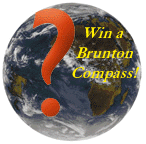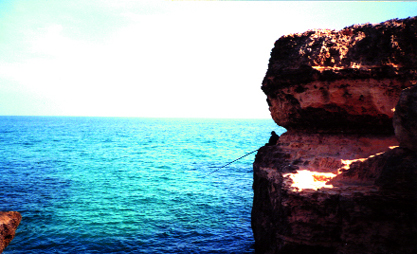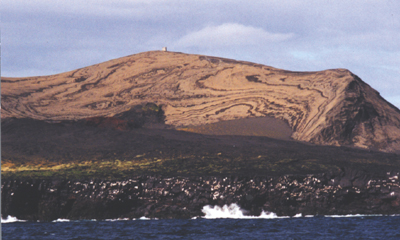Every month, we'd like to feature one of your photos from anywhere in the world and invite other readers to guess where it was taken. Look every month in the print Geotimes for a new photo. Following are clues, answers and winners from past issues.


| Do you have slides and photos you've
collected from field work or vacations? Every month, we'd like to feature one of your photos from anywhere in the world and invite other readers to guess where it was taken. Look every month in the print Geotimes for a new photo. Following are clues, answers and winners from past issues. |
 |
| Send answers for the December 2003 Where on Earth?
contest, which appears in the print magazine, to Geotimes by December
29 (or postmarked by this date). From those answers, Geotimes staff
will draw the names of 10 people who will win Where on Earth? T-shirts.
And from those 10 names, we will draw the names of two people who will win
a Brunton compass.
Click here
to submit a guess for this month's Where on Earth?
contest. Submit
photos for Where on Earth? |

|
Clues: 1. Although sometimes called the "Land Between Two Seas," this peninsula is perhaps better known as the back end of an enormous item of footwear. 2. Carbonate rocks in this region were laid down throughout the entire Cretaceous period. These thick sequences of rock were rapidly uplifted and exposed in the Middle Pleistocene when thick continental lithosphere buckled in the hinge of an adjacent subduction zone. 3. A prominent town in the region is named "beautiful city" in a classical tongue, a sobriquet shared with the site of a 1915 battle that was a turning point for Australia's national identity. Name the region. Scroll down for the answer |
| Answer: Puglia is the southeasternmost region of Italy stretching between the Ionian and Adriatic Seas; it is the heel of Italy's boot. |

|
Clues: 1. Born in a burst of explosive fury in 1963, this oceanic volcano continued to erupt until 1967. After it had built a tephra cone up from the ocean floor, its eruptions became less violent, and basaltic flows poured out onto its flanks. 2. The island is a sanctuary off-limits to casual visitors, to enable scientists to observe and record its pristine ecologic development. Green plants and abundant seabirds have established colonies above its shores. 3. The island is named after a Norse god of fire. Scroll down for the answer
|
|
Answer: Surtsey volcano, about 35 kilometers southwest of Iceland in the North Atlantic Ocean. Photo and clues provided by Wallace Hansen of Lakewood, Colo. |
October Winners
1. Polly Bass (Athens, Ga.)
2. Heather Brown (Vancouver, B.C.)
3. William A. Crawford (Bryn Mawr, Pa.)
4. Ken Ferrone (Concord, Calif.)
5. Steven R. Gustison (Champaign, Ill.)
6. Art Johnson (Kenner, La.)
7. Keith Meldahl (Encinitas, Calif.)
8. Rachel Paull (Littleton, Colo.)
9. John Reid (Fort Collins, Colo.)
10. Don Wason (Barrington, N.H.)
 |
Geotimes Home | AGI Home | Information Services | Geoscience Education | Public Policy | Programs | Publications | Careers |